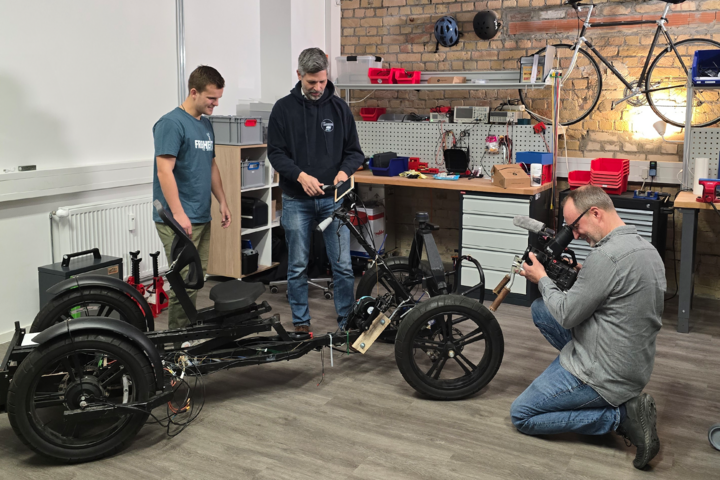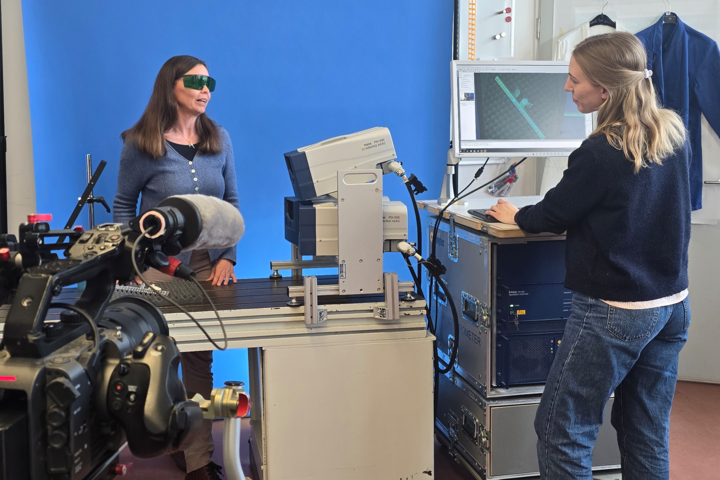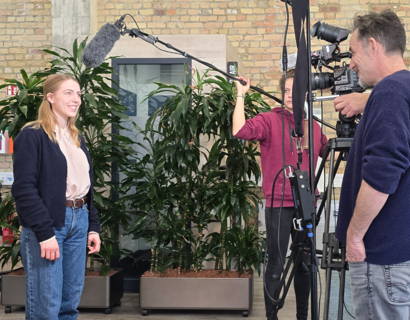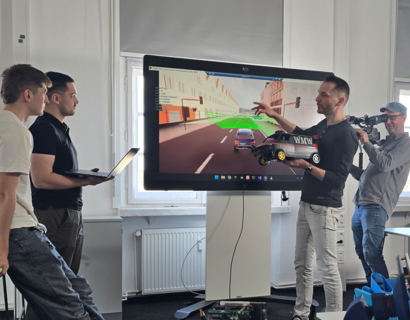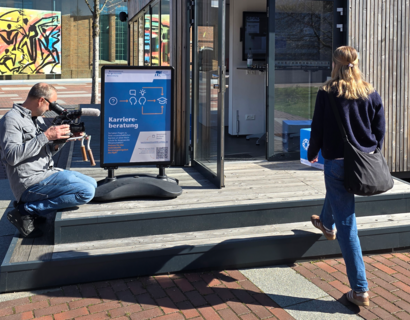Vom Storyboard zur Realität: unser Abenteuer Imagevideo
Wie entsteht ein Imagefilm, der nicht nur informiert, sondern begeistert? Zwischen Storyboard, Drehtag und jeder Menge Improvisation erzählt das KpE-Team von seinem ganz eigenen Filmabenteuer – und davon, wie aus Planung, Kreativität und Teamgeist ein einzigartiges Ergebnis wurde. Ein Bericht von Ilona Kunkel. +++ English version below +++
Ein großes Projekt erfordert Mut, einen guten Plan, dennoch Raum für Flexibilität und vor allem: ein starkes Team – so unser Learning aus dem Projekt „Imagevideo“, das uns am Karrierezentrum für professorale Entwicklung (KpE) in den letzten Monaten beschäftigt hat. Als wir am KpE die Entscheidung getroffen haben, ein Imagevideo zum Berufsbild der Professur an einer Hochschule für angewandte Wissenschaften (HAW) in Auftrag zu geben, hatten wir natürlich eine Vorstellung davon, wie die Arbeit an diesem Projekt laufen würde – und wurden doch immer wieder überrascht.
Der Plan für das Video war denkbar simpel: ein Imagefilm, der Professor*innen unserer Hochschule ins Rampenlicht rückt und so das Berufsbild der HAW-Professur in all seinen Facetten zeigt. Ein Film, der kommuniziert: An HAWs können Sie selbstbestimmt lehren, forschen, gestalten … und an der TH Wildau geht das sogar besonders gut! Außerdem unsere Idee: Der Film sollte im Meer aus Imagefilmen positiv hervorstechen – durch eine Kombination aus Realfilm- und Animationssequenzen. Protagonistin der Animationssequenzen sollte eine imaginierte angehende Professorin sein, die den Karriereweg vom ersten zaghaften Interesse am Berufsbild bis hin zur Berufung an die TH Wildau durchläuft und den Betrachtenden viele Identifikationsangebote macht.
Professor*innen und Promovendin als Testimonials
Die Suche nach geeigneten Agenturen, die das Projekt mit uns umsetzen würden, führte schnell zum Erfolg: Die Berliner Agentur Dreikantfilm um Sebastian Holzapfel, die in der Vergangenheit schon ein Imagevideo für die TH Wildau angefertigt hatte und daher die Hochschule bereits gut kannte, überzeugte mit ihrem Angebot ebenso wie unser Design-Rahmenvertragspartner, studio_upstruct aus Berlin, das schon auf viele erfolgreiche Projekte mit der TH Wildau zurückschaut. Hier war es im besonderen Markus Dittrich, der sich des Animationsteils annahm. Mehrere Abstimmungsrunden später: endlich das fertige Konzept mit Storyboard sowie drei Professor*innen und eine Promovendin, die bereit sind, als Testimonials im Film aufzutreten.
Und schließlich kam der Drehtag selbst. Noch im Morgengrauen, gegen 7:20 Uhr morgens, reiste das vierköpfige Filmteam um Sebastian Holzapfel an. Erster Drehort: Das Radverkehrslabor von Prof. Christian Rudolph in der Lok21. Es wurden Schnittbilder von der Arbeit im Labor gemacht, aber auch Aufnahmen von Christian Rudolph beim Fahrradfahren und Interaktion mit einem Studenten und einer Mitarbeiterin.
Auch eine Interviewsequenz durfte nicht fehlen – mit unerwarteten Hindernissen: Die Lok21 ist morgens ein frequentierter Arbeitsort und die schweren Türen machen im weitläufigen Gebäude beim Auf- und Zugehen laut hallende Geräusche. Eine schnelle Lösung musste also her, um die Tonspur des Videos nicht zu gefährden. Kurzerhand platzierten sich Susanne Voltmer und Ilona Kunkel vom KpE an den beiden Eingängen zur Halle, baten alle Passant*innen um leises Gehen und Flüstern und öffneten bzw. schlossen die Tür selbst von Hand, um jegliche lauten Geräusche zu vermeiden – ein vertretbarer Einsatz für das gemeinsame Ziel! Der Drehtag ging weiter in der Science Box, wo Susanne Voltmer vom KpE eine Karriereberatung mit der Promovendin Annika Schmidt nachstellte. Um im Video auch deutlich zu vermitteln, dass es sich um eine Beratungssituation handelt, fehlte noch ein strategisch platziertes Plakat. Glücklicherweise sprangen Lisa Hettler und Dajana Kossack vom KpE kurzerhand ein und schleppten einen Kundenstopper ans Set, der heute im fertigen Video zu sehen ist und die Szene thematisch einbettet.
Apropos thematische Einbettung: In das „Vergnügen“, einzelne Textpassagen und Szenen gefühlte 100 Mal wiederholen zu müssen, kamen am Drehtag irgendwann alle Protagonist*innen. Natürlich können im Film Szenen geschnitten und störende Elemente im Redefluss zu einem gewissen Grad entfernt werden. Doch bei manchen Sequenzen zählt eine punktgenaue Sprache und sehr präzise Ausdrucksweise – die alle Protagonist*innen am Ende mit Bravour (und Geduld) gemeistert haben.
Wie lässt sich Wissenschaft in Szene setzen?
Nächster Drehort: Das Maschinendynamiklabor mit Akustikkammer von Prof. Dina Hannebauer, die bei der Arbeit mit ihrer Promovendin Annika Schmidt und zwei anderen Promovierenden gefilmt wurde. Eine spannende Frage gab es hier im Labor zu diskutieren: Wie lässt sich Wissenschaft für ein fachfremdes Publikum ästhetisch in Szene setzen?
Der innovative Laser, an dem im Labor an aktuellen Forschungsfragen gearbeitet wird, ist in seiner Funktion schwierig zu erfassen, wenn man nicht „vom Fach“ ist. Gleichzeitig kann bei den Betrachtenden des Imagevideos kein Maschinendynamik-Vorwissen vorausgesetzt werden und der Film sollte selbsterklärend sein. Die Lösung des Dreikantfilm-Teams: der Laser wurde mittels Lichteinsatz und Kameraführung als modernes Laborgerät inszeniert. Dina Hannebauer setzte in der entsprechenden Szene eine Laserschutzbrille auf, um die Arbeitssituation mit dem Laser realitätsnah darzustellen.
Freiheit in Forschung und Lehre als Interviewthema
Letzte Station des Tages: Das Future Mobility Center in Haus 24 unter der Leitung von Prof. Stefan Kubica, der in seiner Interviewsequenz über die Freiheit in Forschung und Lehre als Hochschulprofessor spricht. In den Schnittbildern ging es darum, Lehre und Arbeit im Studiengang einzufangen: mit tatkräftiger Unterstützung dreier Mitarbeitender von Stefan Kubica – und Ilona Kunkel vom KpE als zusätzliche Statistin, um eine größere „Masse“ an Studierenden zu zeigen.
Ein langer und aufregender Drehtag ging schließlich zu Ende und alle geplanten Szenen waren im Kasten! Wieder hat sich gezeigt: wie detailliert auch die Planung ist, am Set geschieht immer Unvorhergesehenes. Dann braucht es erstens gute Ideen für schnelle und praktische Lösungen, zweitens eine Hands-On-Einstellung, und drittens und am wichtigsten: ein Projektteam, auf das Verlass ist!
Der fertige Imagefilm
English: From storyboard to reality: our image video adventureBereich öffnenBereich schließen
From storyboard to reality: our image video adventure
How do you create an image film that not only informs but also inspires? Between storyboard, shooting day, and lots of improvisation, the KpE team talks about its very own film adventure—and how planning, creativity, and team spirit resulted in a unique outcome. A report by Ilona Kunkel.
A big project requires courage, a good plan, yet room for flexibility and, above all, a strong team – that's what we learned from the “image video” project that has kept us busy at the Career Center for Professorial Development (KpE) over the past few months. When we at KpE decided to commission an image video about the profession of professor at a university of applied sciences (HAW), we naturally had an idea of how the work on this project would proceed – and yet we were surprised again and again.
The plan for the video was very simple: an image film that puts the professors at our university in the spotlight and thus shows all facets of the job profile of a HAW professor. A film that communicates: at HAWs, you can teach, research, and design independently... and at TH Wildau, this is particularly easy to do! Our idea was also that the film should stand out positively from the sea of image films – through a combination of live-action and animated sequences. The protagonist of the animated sequences was to be an imaginary aspiring professor who goes through the career path from her first tentative interest in the profession to her appointment at TH Wildau, offering viewers many opportunities to identify with her.
Professors and doctoral candidate as testimonials
The search for suitable agencies to implement the project with us quickly led to success: the Berlin agency Dreikantfilm, led by Sebastian Holzapfel, which had already produced an image video for TH Wildau in the past and therefore knew the university well, impressed us with its offer, as did our design framework agreement partner, studio_upstruct from Berlin, which can already look back on many successful projects with TH Wildau. Markus Dittrich was particularly involved in the animation part. Several rounds of coordination later, the finished concept with storyboard was finally ready, and three professors and a doctoral student were willing to appear as testimonials in the film.
Creative solutions during filming
And finally, the day of filming arrived. At dawn, around 7:20 a.m., the four-person film crew led by Sebastian Holzapfel arrived. First location: Prof. Christian Rudolph's bicycle traffic laboratory in Lok21. Cutaway shots were taken of the work in the laboratory, as well as footage of Christian Rudolph riding a bicycle and interacting with a student and a staff member.
An interview sequence was also a must—but there were unexpected obstacles: Lok21 is a busy workplace in the morning, and the heavy doors in the spacious building make loud echoing noises when opened and closed. A quick solution was needed to avoid compromising the video's soundtrack. Without further ado, Susanne Voltmer and Ilona Kunkel from KpE positioned themselves at the two entrances to the hall, asked all passers-by to walk quietly and whisper, and opened and closed the doors themselves by hand to avoid any loud noises – a reasonable effort for the common goal!
The day of filming continued in the Science Box, where Susanne Voltmer from KpE reenacted a career counseling session with doctoral student Annika Schmidt. To clearly convey in the video that this was a counseling situation, a strategically placed poster was still needed. Fortunately, Lisa Hettler and Dajana Kossack from KpE jumped in at short notice and brought a customer stopper to the set, which can be seen in the finished video today and embeds the scene thematically.
Speaking of thematic embedding: on the day of filming, all the protagonists eventually had the “pleasure” of repeating individual text passages and scenes what felt like 100 times. Of course, scenes can be edited in the film and distracting elements in the flow of speech can be removed to a certain extent. But in some sequences, precise language and very precise expression are important – which all the protagonists mastered with flying colors (and patience) in the end.
How can science be staged?
Next filming location: Prof. Dina Hannebauer's machine dynamics laboratory with acoustic chamber, where she was filmed working with her doctoral student Annika Schmidt and two other doctoral students. There was an exciting question to discuss here in the laboratory: How can science be staged aesthetically for an audience unfamiliar with the subject? The innovative laser used in the laboratory to work on current research questions is difficult to understand if you are not an expert in the field. At the same time, viewers of the image video cannot be expected to have any prior knowledge of machine dynamics, and the film should be self-explanatory. The solution of the Dreikantfilm team: the laser was staged as a modern laboratory device using lighting and camera work. Dina Hannebauer wore laser safety goggles in the corresponding scene to realistically portray the working situation with the laser.
Last stop of the day: the Future Mobility Center in Building 24, headed by Prof. Stefan Kubica, who talks about freedom in research and teaching as a university professor in his interview sequence. The cutaway shots were intended to capture teaching and work in the degree program: with the active support of three of Stefan Kubica's colleagues – and Ilona Kunkel from KpE as an additional extra to show a larger “crowd” of students.
A long and exciting day of filming finally came to an end and all the planned scenes were in the can! Once again, it became clear that no matter how detailed the planning is, the unexpected always happens on set. This requires, first, good ideas for quick and practical solutions, second, a hands-on attitude, and third, and most importantly, a project team you can rely on!
Fachliche Ansprechperson
Dr. phil. Ilona Kunkel
Präsidium
Projektmitarbeiterin Diversitätssensibles Marketing, Karrierezentrum für professorale Entwicklung
Tel.: +49 3375 508 675
Mail: ilona.kunkel@th-wildau.de
Web: https://www.th-wildau.de/karrierezentrum
Haus 13, Raum 038
Redaktionelle Ansprechperson
Bettina Rehmann
Zentrum für Hochschulkommunikation
Interne/Externe Kommunikation
Tel.: +49 3375 508 354
Mail: bettina.rehmann@th-wildau.de
Web: http:www.th-wildau.de/interne-kommunikation
Haus 21, Raum A102

